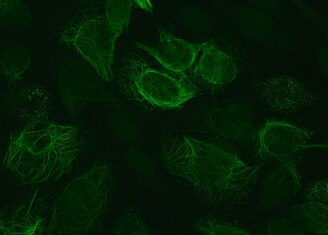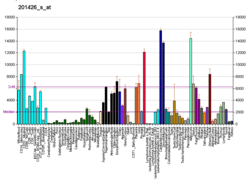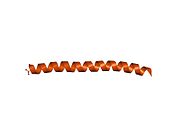| Revision as of 00:57, 25 October 2017 edit72.186.90.24 (talk) →Interactions← Previous edit | Revision as of 18:36, 25 January 2018 edit undo91.224.151.60 (talk) →Clinical significance: JdjfgfkuffkfuTags: Mobile edit Mobile web editNext edit → | ||
| Line 25: | Line 25: | ||
| == Clinical significance == | == Clinical significance == | ||
| It has been used as a ] ] to identify ].<ref name="pmid2435649">{{cite journal |vauthors=Leader M, Collins M, Patel J, Henry K |title=Vimentin: an evaluation of its role as a tumour marker |journal=Histopathology |volume=11 |issue=1 | |
It has been used as a ] ] to identify ].<ref name="pmid2435649">{{cite journal |vauthors=Leader M, Collins M, Patel J, Henry K |title=Vimentin: an evaluation of its role as a tumour marker |journal=Histopathology |volume=11 |issue=1 |pagesthyhtjy=63–72 |date=January 1987 |pmid=2435649 |doi= 10.1111/j.1365-2559.1987.tb02609.x|url=}}</ref><ref name="urlImmunohistochemistry from the Washington Animal Disease Diagnostic laboratory (WADDL)of the College of Veterinary Medicine, Washington State University">{{cite web |url=http://www.vetmed.wsu.edu/depts_Waddl/ICS.aspx |title=Immunohistochemistry from the Washington Animal Disease Diagnostic laboratory (WADDL)of the College of Veterinary Medicine, Washington State University |format= |work= |accessdate=2009-03-14}}</ref> | ||
| Methylation of the vimentin gene has been established as a biomarker of colon cancer and this is being utilized in the development of fecal tests for colon cancer. Statistically significant levels of vimentin gene methylation have also been observed in certain upper gastrointestinal pathologies such as ], esophageal adenocarcinoma, and intestinal type gastric cancer.<ref>{{cite journal|last=Moinova|first=Helen|title=Aberrant Vimentin Methylation is Characteristic of Upper GI Pathologies|journal=Cancer Epidemiology, Biomarkers & Prevention|date=April 2012|volume=21|issue=4|pages=594–600|doi=10.1158/1055-9965.epi-11-1060}}</ref> High levels of DNA methylation in the promotor region have also been associated with markedly decreased survival in hormone positive breast cancers.<ref>{{cite journal|last=Ulirsch|first=Jacob|title=Vimentin DNA methylation predicts survival in breast cancer|journal=Breast Cancer Research and Treatment|date=January 2013|doi=10.1007/s10549-012-2353-5|pmid=23239149|volume=137|issue=2|pages=383–96|pmc=3838916}}</ref> | Methylation of the vimentin gene has been established as a biomarker of colon cancer and this is being utilized in the development of fecal tests for colon cancer. Statistically significant levels of vimentin gene methylation have also been observed in certain upper gastrointestinal pathologies such as ], esophageal adenocarcinoma, and intestinal type gastric cancer.<ref>{{cite journal|last=Moinova|first=Helen|title=Aberrant Vimentin Methylation is Characteristic of Upper GI Pathologies|journal=Cancer Epidemiology, Biomarkers & Prevention|date=April 2012|volume=21|issue=4|pages=594–600|doi=10.1158/1055-9965.epi-11-1060}}</ref> High levels of DNA methylation in the promotor region have also been associated with markedly decreased survival in hormone positive breast cancers.<ref>{{cite journal|last=Ulirsch|first=Jacob|title=Vimentin DNA methylation predicts survival in breast cancer|journal=Breast Cancer Research and Treatment|date=January 2013|doi=10.1007/s10549-012-2353-5|pmid=23239149|volume=137|issue=2|pages=383–96|pmc=3838916}}</ref> | ||
Revision as of 18:36, 25 January 2018

Vimentin is a protein that in humans is encoded by the VIM gene.
Vimentin is a type III intermediate filament (IF) protein that is expressed in mesenchymal cells. IF proteins are found in all metazoan cells as well as bacteria. IF, along with tubulin-based microtubules and actin-based microfilaments, comprises the cytoskeleton. All IF proteins are expressed in a highly developmentally-regulated fashion; vimentin is the major cytoskeletal component of mesenchymal cells. Because of this, vimentin is often used as a marker of mesenchymally-derived cells or cells undergoing an epithelial-to-mesenchymal transition (EMT) during both normal development and metastatic progression.
Structure
A vimentin monomer, like all other intermediate filaments, has a central α-helical domain, capped on each end by non-helical amino (head) and carboxyl (tail) domains. Two monomers are likely co-translationally expressed in a way that facilitates their formation of a coiled-coil dimer, which is the basic subunit of vimentin assembly.
The α-helical sequences contain a pattern of hydrophobic amino acids that contribute to forming a "hydrophobic seal" on the surface of the helix. In addition, there is a periodic distribution of acidic and basic amino acids that seems to play an important role in stabilizing coiled-coil dimers. The spacing of the charged residues is optimal for ionic salt bridges, which allows for the stabilization of the α-helix structure. While this type of stabilization is intuitive for intrachain interactions, rather than interchain interactions, scientists have proposed that perhaps the switch from intrachain salt bridges formed by acidic and basic residues to the interchain ionic associations contributes to the assembly of the filament.
Function
Vimentin plays a significant role in supporting and anchoring the position of the organelles in the cytosol. Vimentin is attached to the nucleus, endoplasmic reticulum, and mitochondria, either laterally or terminally.
The dynamic nature of vimentin is important when offering flexibility to the cell. Scientists found that vimentin provided cells with a resilience absent from the microtubule or actin filament networks, when under mechanical stress in vivo. Therefore, in general, it is accepted that vimentin is the cytoskeletal component responsible for maintaining cell integrity. (It was found that cells without vimentin are extremely delicate when disturbed with a micropuncture). Transgenic mice that lack vimentin appeared normal and did not show functional differences. It is possible that the microtubule network may have compensated for the absence of the intermediate network. This result supports an intimate interactions between microtubules and vimentin. Moreover, when microtubule depolymerizers were present, vimentin reorganization occurred, once again implying a relationship between the two systems. On the other hand, wounded mice that lack the vimentin gene heal slower than their wild type counterparts.
In essence, vimentin is responsible for maintaining cell shape, integrity of the cytoplasm, and stabilizing cytoskeletal interactions. Vimentin has been shown to eliminate toxic proteins in JUNQ and IPOD inclusion bodies in asymmetric division of mammalian cell lines.
Also, vimentin is found to control the transport of low-density lipoprotein, LDL, -derived cholesterol from a lysosome to the site of esterification. With the blocking of transport of LDL-derived cholesterol inside the cell, cells were found to store a much lower percentage of the lipoprotein than normal cells with vimentin. This dependence seems to be the first process of a biochemical function in any cell that depends on a cellular intermediate filament network. This type of dependence has ramifications on the adrenal cells, which rely on cholesteryl esters derived from LDL.
Vimentin plays a role in aggresome formation, where it forms a cage surrounding a core of aggregated protein.
Clinical significance
It has been used as a sarcoma tumor marker to identify mesenchyme.
Methylation of the vimentin gene has been established as a biomarker of colon cancer and this is being utilized in the development of fecal tests for colon cancer. Statistically significant levels of vimentin gene methylation have also been observed in certain upper gastrointestinal pathologies such as Barrett's esophagus, esophageal adenocarcinoma, and intestinal type gastric cancer. High levels of DNA methylation in the promotor region have also been associated with markedly decreased survival in hormone positive breast cancers. Downregulation of vimentin was identified in cystic variant of papillary thyroid carcinoma using a proteomic approach. See also Anti-citrullinated protein antibody for its use in diagnosis of rheumatoid arthritis.
Interactions
Vimentin has been shown to interact with:
The 3' UTR of Vimentin mRNA has been found to bind a 46kDa protein.
References
- ^ GRCh38: Ensembl release 89: ENSG00000026025 – Ensembl, May 2017
- ^ GRCm38: Ensembl release 89: ENSMUSG00000026728 – Ensembl, May 2017
- "Human PubMed Reference:". National Center for Biotechnology Information, U.S. National Library of Medicine.
- "Mouse PubMed Reference:". National Center for Biotechnology Information, U.S. National Library of Medicine.
- Eriksson JE, Dechat T, Grin B, Helfand B, Mendez M, Pallari HM, Goldman RD (2009). "Introducing intermediate filaments: from discovery to disease". J Clin Invest. 119 (7): 1763–71. doi:10.1172/JCI38339. PMC 2701876. PMID 19587451.
- Cabeen MT, Jacobs-Wagner C (2010). "The bacterial cytoskeleton". Annu Rev Genet. 44: 365–92. doi:10.1146/annurev-genet-102108-134845. PMID 21047262.
- ^ Fuchs E.; Weber K. (1994). "Intermediate filaments: structure, dynamics, function, and disease". Annu Rev Biochem. 63: 345–82. doi:10.1146/annurev.bi.63.070194.002021. PMID 7979242.
- Chang L, Shav-Tal Y, Trcek T, Singer RH, Goldman RD (2006). "Assembling an intermediate filament network by dynamic cotranslation". J Cell Biol. 172 (5): 747–58. doi:10.1083/jcb.200511033. PMC 2063706. PMID 16505169.
- Katsumoto T.; Mitsushima A.; Kurimura T. (1990). "The role of the vimentin intermediate filaments in rat 3Y1 cells elucidated by immunoelectron microscopy and computer-graphic reconstruction". Biol Cell. 68 (2): 139–46. doi:10.1016/0248-4900(90)90299-I. PMID 2192768.
- ^ Goldman RD, Khuon S, Chou YH, Opal P, Steinert PM (August 1996). "The function of intermediate filaments in cell shape and cytoskeletal integrity". J. Cell Biol. 134 (4): 971–83. doi:10.1083/jcb.134.4.971. PMC 2120965. PMID 8769421.
- Golucci-Guyon E, Portier MM, Dunia I, Paulin D, Pournin S, Babinet C (1994). "Mice lacking vimentin develop and reproduce without an obvious phenotype". Cell. 79 (4): 679–94. doi:10.1016/0092-8674(94)90553-3. PMID 7954832.
- Eckes B, Colucci-Guyon E, Smola H, Nodder S, Babinet C, Krieg T, Martin P (2000). "Impaired wound healing in embryonic and adult mice lacking vimentin". Journal of Cell Science. 113: 2455–62. PMID 10852824.
- Ogrodnik M, Salmonowicz H, Brown R, Turkowska J, Sredniawa W, Pattabiraman S, Amen T, Abraham AC, Eichler N, Lyakhovetsky R, Kaganovich D (2014). "Dynamic JUNQ inclusion bodies are asymmetrically inherited in mammalian cell lines through the asymmetric partitioning of vimentin". Proceedings of the National Academy of Sciences of the United States of America. 111 (22): 8049–54. doi:10.1073/pnas.1324035111. PMC 4050583. PMID 24843142.
- ^ Sarria AJ, Panini SR, Evans RM (September 1992). "A functional role for vimentin intermediate filaments in the metabolism of lipoprotein-derived cholesterol in human SW-13 cells". J. Biol. Chem. 267 (27): 19455–63. PMID 1527066.
- Johnston JA, Ward CL, Kopito RR (1998). "Aggresomes: a cellular response to misfolded proteins". J. Cell Biol. 143: 1883–98. doi:10.1083/jcb.143.7.1883. PMC 2175217. PMID 9864362.
- Leader M, Collins M, Patel J, Henry K (January 1987). "Vimentin: an evaluation of its role as a tumour marker". Histopathology. 11 (1). doi:10.1111/j.1365-2559.1987.tb02609.x. PMID 2435649.
{{cite journal}}: Unknown parameter|pagesthyhtjy=ignored (help) - "Immunohistochemistry from the Washington Animal Disease Diagnostic laboratory (WADDL)of the College of Veterinary Medicine, Washington State University". Retrieved 2009-03-14.
- Moinova, Helen (April 2012). "Aberrant Vimentin Methylation is Characteristic of Upper GI Pathologies". Cancer Epidemiology, Biomarkers & Prevention. 21 (4): 594–600. doi:10.1158/1055-9965.epi-11-1060.
- Ulirsch, Jacob (January 2013). "Vimentin DNA methylation predicts survival in breast cancer". Breast Cancer Research and Treatment. 137 (2): 383–96. doi:10.1007/s10549-012-2353-5. PMC 3838916. PMID 23239149.
- Dinets A, Pernemalm M, Kjellin H, Sviatoha V, Sofiadis A, Juhlin CC, Zedenius J, Larsson C, Lehtiö J, Höög A (May 2015). "Differential protein expression profiles of cyst fluid from papillary thyroid carcinoma and benign thyroid lesions". PLOS ONE. 10 (5): e0126472. doi:10.1371/journal.pone.0126472. PMC 4433121. PMID 25978681.
{{cite journal}}: CS1 maint: unflagged free DOI (link) - Meng JJ, Bornslaeger EA, Green KJ, Steinert PM, Ip W (1997). "Two-hybrid analysis reveals fundamental differences in direct interactions between desmoplakin and cell type-specific intermediate filaments". J. Biol. Chem. 272 (34): 21495–503. doi:10.1074/jbc.272.34.21495. PMID 9261168.
{{cite journal}}: CS1 maint: unflagged free DOI (link) - Lopez-Egido J, Cunningham J, Berg M, Oberg K, Bongcam-Rudloff E, Gobl A (2002). "Menin's interaction with glial fibrillary acidic protein and vimentin suggests a role for the intermediate filament network in regulating menin activity". Exp. Cell Res. 278 (2): 175–83. doi:10.1006/excr.2002.5575. PMID 12169273.
- Rual JF, Venkatesan K, Hao T, Hirozane-Kishikawa T, Dricot A, Li N, Berriz GF, Gibbons FD, Dreze M, Ayivi-Guedehoussou N, Klitgord N, Simon C, Boxem M, Milstein S, Rosenberg J, Goldberg DS, Zhang LV, Wong SL, Franklin G, Li S, Albala JS, Lim J, Fraughton C, Llamosas E, Cevik S, Bex C, Lamesch P, Sikorski RS, Vandenhaute J, Zoghbi HY, Smolyar A, Bosak S, Sequerra R, Doucette-Stamm L, Cusick ME, Hill DE, Roth FP, Vidal M (2005). "Towards a proteome-scale map of the human protein-protein interaction network". Nature. 437 (7062): 1173–8. doi:10.1038/nature04209. PMID 16189514.
- Stelzl U, Worm U, Lalowski M, Haenig C, Brembeck FH, Goehler H, Stroedicke M, Zenkner M, Schoenherr A, Koeppen S, Timm J, Mintzlaff S, Abraham C, Bock N, Kietzmann S, Goedde A, Toksöz E, Droege A, Krobitsch S, Korn B, Birchmeier W, Lehrach H, Wanker EE (2005). "A human protein-protein interaction network: a resource for annotating the proteome". Cell. 122 (6): 957–68. doi:10.1016/j.cell.2005.08.029. PMID 16169070.
- Herrmann H, Wiche G (1987). "Plectin and IFAP-300K are homologous proteins binding to microtubule-associated proteins 1 and 2 and to the 240-kilodalton subunit of spectrin". J. Biol. Chem. 262 (3): 1320–5. PMID 3027087.
- ^ Brown MJ, Hallam JA, Liu Y, Yamada KM, Shaw S (2001). "Cutting edge: integration of human T lymphocyte cytoskeleton by the cytolinker plectin". J. Immunol. 167 (2): 641–5. doi:10.4049/jimmunol.167.2.641. PMID 11441066.
- Matsuzawa K, Kosako H, Inagaki N, Shibata H, Mukai H, Ono Y, Amano M, Kaibuchi K, Matsuura Y, Azuma I, Inagaki M (1997). "Domain-specific phosphorylation of vimentin and glial fibrillary acidic protein by PKN". Biochem. Biophys. Res. Commun. 234 (3): 621–5. doi:10.1006/bbrc.1997.6669. PMID 9175763.
- Russell RL, Cao D, Zhang D, Handschumacher RE, Pizzorno G (2001). "Uridine phosphorylase association with vimentin. Intracellular distribution and localization". J. Biol. Chem. 276 (16): 13302–7. doi:10.1074/jbc.M008512200. PMID 11278417.
{{cite journal}}: CS1 maint: unflagged free DOI (link) - Tzivion G, Luo ZJ, Avruch J (2000). "Calyculin A-induced vimentin phosphorylation sequesters 14-3-3 and displaces other 14-3-3 partners in vivo". J. Biol. Chem. 275 (38): 29772–8. doi:10.1074/jbc.M001207200. PMID 10887173.
{{cite journal}}: CS1 maint: unflagged free DOI (link) - Ratnayake WS, Apostolatos AH, Ostrov DA, Acevedo-Duncan M (2017). "Two novel atypical PKC inhibitors; ACPD and DNDA effectively mitigate cell proliferation and epithelial to mesenchymal transition of metastatic melanoma while inducing apoptosis". Int. J. Oncol. 51 (5): 1370–1382. doi:10.3892/ijo.2017.4131. PMID 29048609.
- Zehner ZE, Shepherd RK, Gabryszuk J, Fu TF, Al-Ali M, Holmes WM (August 1997). "RNA-protein interactions within the 3 ' untranslated region of vimentin mRNA". Nucleic Acids Res. 25 (16): 3362–70. doi:10.1093/nar/25.16.3362. PMC 146884. PMID 9241253.
Further reading
- Snásel J, Pichová I (1997). "The cleavage of host cell proteins by HIV-1 protease". Folia Biol. (Praha). 42 (5): 227–30. doi:10.1007/BF02818986. PMID 8997639.
- Lake JA, Carr J, Feng F, et al. (2003). "The role of Vif during HIV-1 infection: interaction with novel host cellular factors". J. Clin. Virol. 26 (2): 143–52. doi:10.1016/S1386-6532(02)00113-0. PMID 12600646.
External links
| PDB gallery | |
|---|---|
| Proteins of the cytoskeleton | |||||||||||||||||||||||||||||||||||||||||||||||||||||
|---|---|---|---|---|---|---|---|---|---|---|---|---|---|---|---|---|---|---|---|---|---|---|---|---|---|---|---|---|---|---|---|---|---|---|---|---|---|---|---|---|---|---|---|---|---|---|---|---|---|---|---|---|---|
| Human |
| ||||||||||||||||||||||||||||||||||||||||||||||||||||
| Nonhuman | |||||||||||||||||||||||||||||||||||||||||||||||||||||
| See also: cytoskeletal defects | |||||||||||||||||||||||||||||||||||||||||||||||||||||
| Tumor markers | |||||||||||||
|---|---|---|---|---|---|---|---|---|---|---|---|---|---|
| Blood |
| ||||||||||||
| Endocrine |
| ||||||||||||
| Nervous system |
| ||||||||||||
| Cardiovascular/ respiratory |
| ||||||||||||
| Digestive |
| ||||||||||||
| Reproductive/ urinary/ breast |
| ||||||||||||
| General histology |
| ||||||||||||
| Musculoskeletal |
| ||||||||||||







